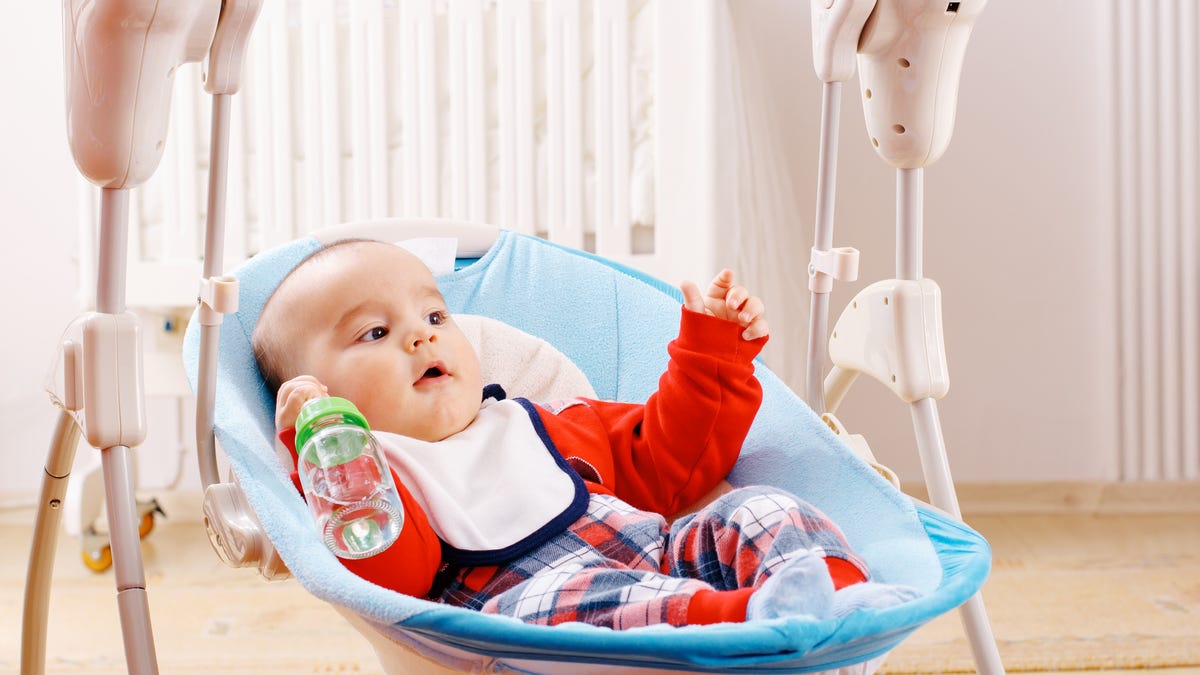Your Baby Will Only Sleep in a Swing? Here's How to Break the Habit
A baby swing can calm a fussy child but doesn't provide the support needed to keep them in a safe position as they sleep. These tips will help you transition your baby to their crib.

A baby swing most likely made its way to your baby registry. New parents and babies love swings because they're a great way to calm and soothe a restless child.
Even though baby swings can keep your baby entertained while giving you a much-needed arm break, experts warn that there are potential risks to letting your child take a snooze in one.
This guide explains safe ways to use a baby swing, why your child shouldn't sleep in one and how to help your child transition to sleeping in their crib or bassinet.
How to safely use a baby swing
Baby swings can be an instant mood enhancer. The constant motion can provide a soothing sensation for a fussy baby.
However, this isn't a one-size-fits-all solution. Some swings can overstimulate babies. In these instances, you can adjust the speed of the motion until your baby is at ease.
The American Academy of Pediatrics recommends these best practices to keep your child safe in a baby swing:
- Ensure the baby swing is right for your baby's weight. Most models allow newborns to use one until they reach a weight threshold -- normally, it's between 25 and 35 pounds, but it's best to check your device's owner's manual for specifics on your model.
- Set the swing to the most reclined position is best for babies aged 4 months and younger.
- You should also assess the swing's sturdiness to ensure that it doesn't topple over.
- Secure your child with the safety straps. The instruction booklet contains steps on how to ensure you have your baby strapped correctly.
- The cradle should be flat when the swing rocks back and forth.
- Attach toys to the swing securely to avoid objects from falling and hurting your child.
- Stay informed of all recalls relating to baby swings. If you have a model with a recall, contact your manufacturer to determine the next steps.
Is it safe for my baby to sleep in a swing?
No, it isn't safe for your baby to sleep in a swing. Infants haven't developed their muscles enough to hold up their heads. Babies easily fall asleep anywhere, so they might try to take a nap in the swing. If they're not in a reclined position, they might slump their head forward, which can block their oxygen flow.
With this in mind, if you plan to use a swing to help calm your baby, make sure it offers reclined positions so you can adjust accordingly.
Also, keep a close eye on their posture when they're in the swing. If you notice their neck or head dropping forward, you can adjust their seating, recline the swing more or remove them from it.
Read more: Baby Carrier, Sling or Wrap: Which Should You Choose?
Potential risks of babies sleeping in swings
When a baby falls asleep and they're not in a reclined position, the weight of their head might cause their head to droop forward. In some cases, it could cut off the oxygen supply, resulting in suffocation.
Babies need a flat, firm surface to help them sleep safely. If you notice your baby keeps falling asleep in the swing, here are some ways to break the habit.
How to break the habit
We know that the risk of waking up your baby when they've fallen asleep in a swing might have you on the fence of moving them to another place. But training your baby to sleep in their crib early on will stop them from only wanting to sleep in their swing.
Here are some tips to breaking your baby's habit of sleeping in a swing:
- If you notice your baby getting drowsy in the swing, slowly and softly lift them out and move them to a firm, flat surface like a crib or bassinet.
- If they've already fallen asleep in their baby swing, take them out as soon as you notice.
- If they refuse to sleep anywhere but the swing, limit the time they spend in it.
- Keep the baby swing close to their play area and ensure the space is well lit so the baby associates the swing with playtime instead of sleep time.
If your baby still refuses to sleep anywhere but the swing, it may be time to consult your doctor. There may be an underlying issue that makes your baby uncomfortable sleeping in their crib.